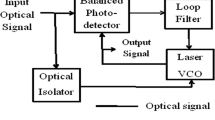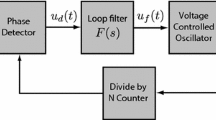Abstract
In this paper, the properties of the optical phase-locked loop(PLL) based on the four-wave mixing in the semiconductor laser amplifiers (SLAs) are discussed. The components that achieve the function of detecting the bit phase of the input optical signal are concerned and discussed in detail together as a function module named as the optical bit phase detector referred to the general electronic PLL. Therefore, most of the properties of the optical PLL can be analyzed by applying the general phase-locked theory. Here the stability of the optical PLL is discussed. It's shown that the variance of input signal power in the practical application will cause optical PLL system unstable because of its long loop delay. The influence on the output phase jitter of the optical PLL is also investigated.
Similar content being viewed by others
References
S. Kawanishi and M. Saruwatari. New-type phase-locked loop using traveling-wave laser diode optical amplifier for very high-speed optical transmission. Electron. Lett., 1988, 24:1452~1453
O. Kamatani et al. 6.3Ghz clock recovery from 50Gb/s TDM optical signal with 50Ghz PLL using four-wave-mixing in a travelling wave laser diode optical amplifier. Electron. Lett., 1994, 30:807~809
O. Kamatani et al. Prescaled timing extraction from 400Gb/s optical signal using a phase look loop based on Four-wave-mixing in a laser diode amplifier. IEEE Photon. Lett., 1996, 8:1094~1096
S. Kawanishi et al. Ultra-high-speed PLL-type clock recovery circuit based on all-optical gain modulation in traveling-wave laser diode amplifier. J. Lightwave Technol., 1993, 11:2123~2129
G.P. Agrawal, et al. Self-phase modulation and spectral broadening of optical pulses in semiconductor laser amplifiers. IEEE J. Quant. Electron., 1989, 25:2297~2306
M. Shtaif et al., Analytical solution of wave mixing between short optical pulses in a semiconductor optical amplifier. Appl. Phys. Lett. 1995, 66:1458~1460
F.M. Gardner, Phaselock Techniques, New York: John Wiley & Sons, 1979
A. D'Ottavi, et al. Efficiency and noise performance of wavelength converters based on FWM in semiconductor optical amplifiers. IEEE Photon. Lett., 1995, 7: 357~360
Author information
Authors and Affiliations
Rights and permissions
About this article
Cite this article
Chen, M., Yao, M., Lou, C. et al. Properties of Optical Phase-Locked Loop Based on Four Wave Mixing in Semiconductor Laser Amplifiers. International Journal of Infrared and Millimeter Waves 19, 1721–1734 (1998). https://doi.org/10.1023/A:1021775428899
Issue Date:
DOI: https://doi.org/10.1023/A:1021775428899




